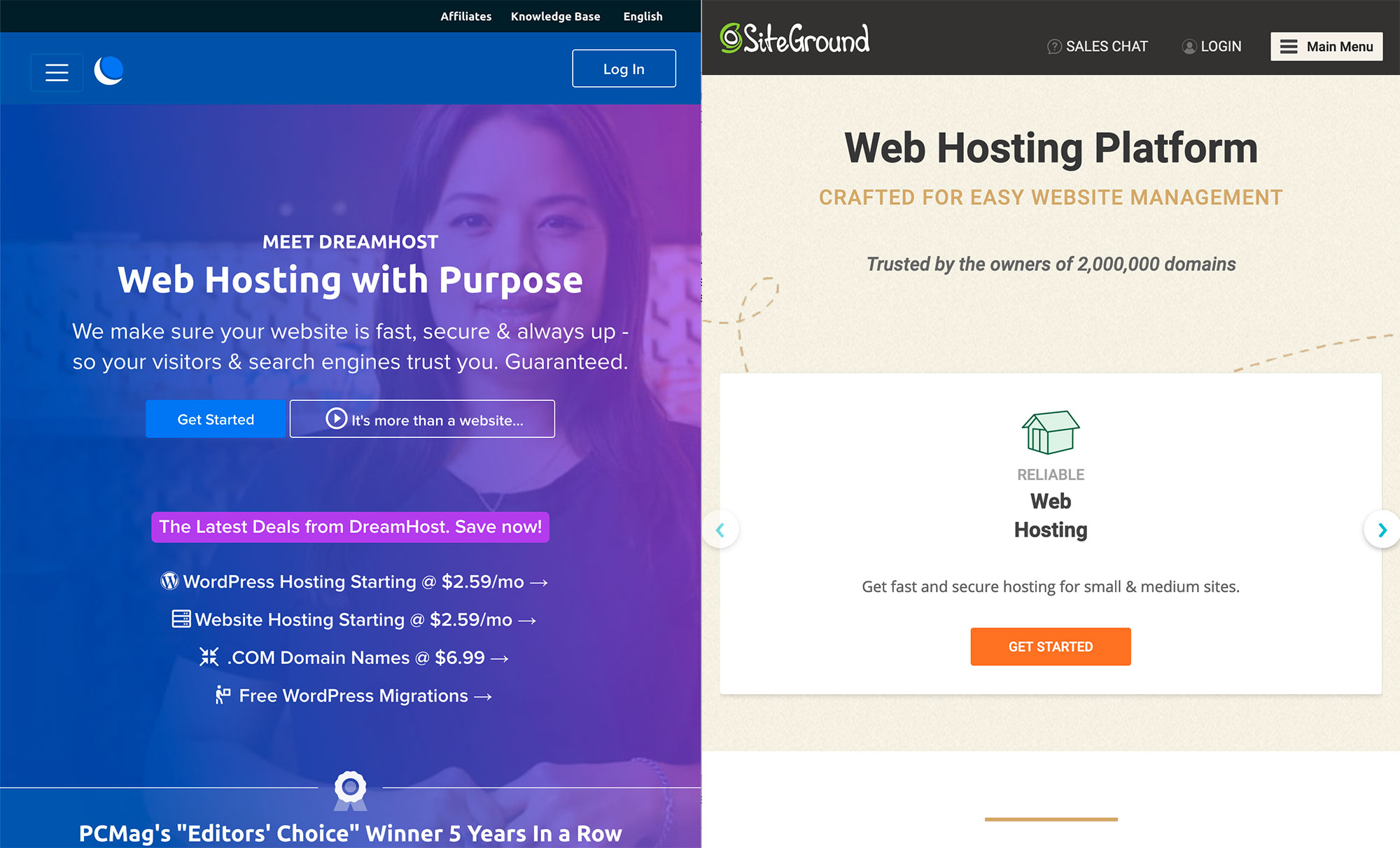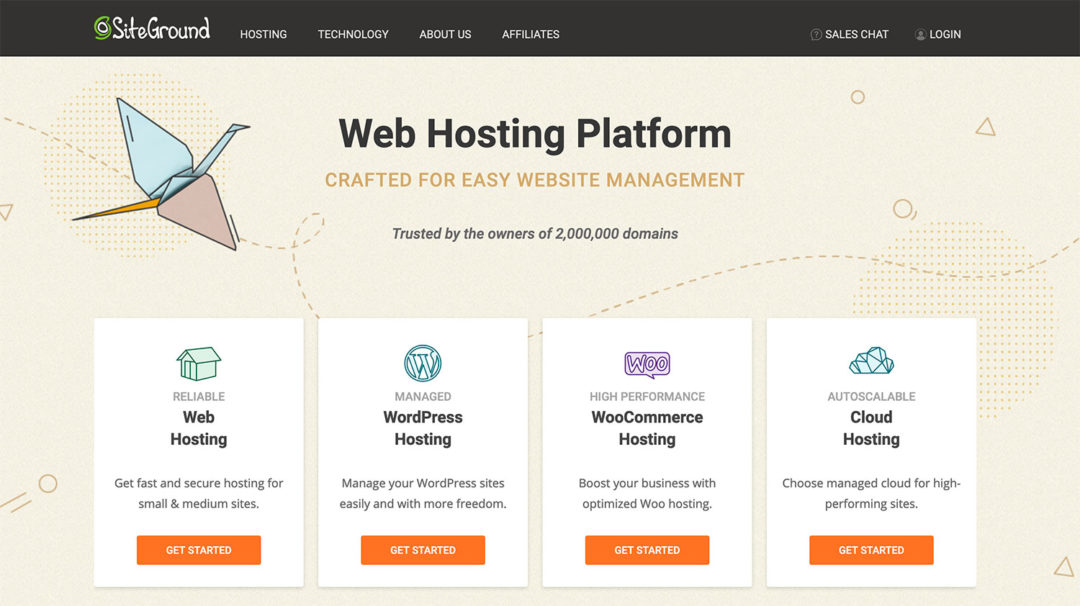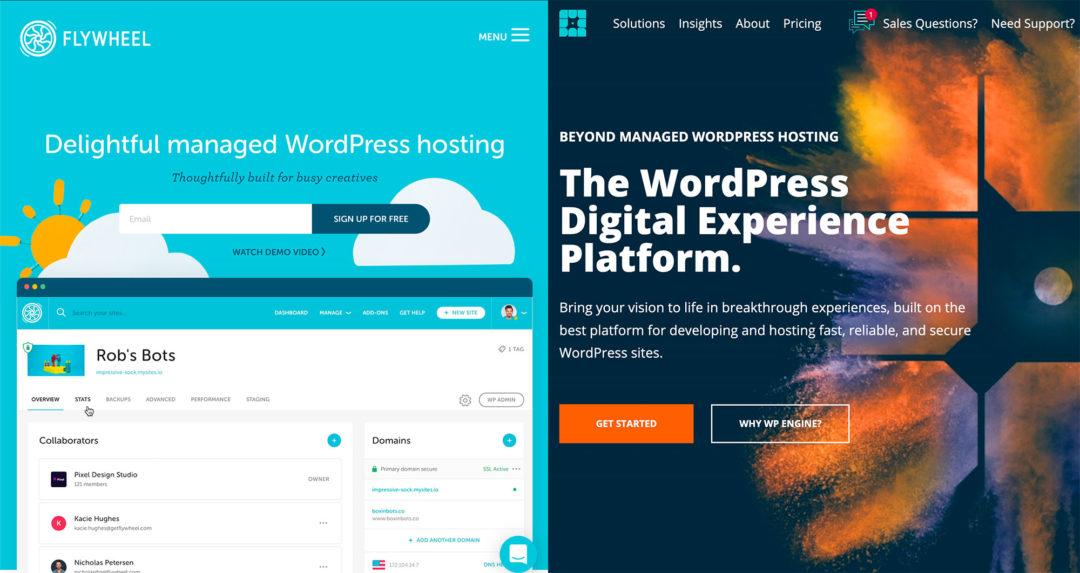Trying to pick between SiteGround vs DreamHost to host your WordPress website?
These are both two of the most popular independent WordPress hosts — and this is also a pretty interesting comparison, because both are solid options in their own right, but each excels in different areas when it comes to WordPress hosting.
In general, SiteGround are the winner when it comes to offering the absolute best hosting product. They make your WordPress site load faster, and they also have a better reputation when it comes to support. However, the complicating factor is SiteGround are considerably more expensive than DreamHost — up to three times more expensive, in fact, depending on your plan. When you factor in this price difference, picking between them becomes a lot more difficult because DreamHost are still pretty good and a whole lot cheaper.
So, in the end, this decision kind of comes down to ‘expensive + top-notch shared WordPress hosting’ (SiteGround) vs ‘value and still pretty good WordPress hosting’ (DreamHost).
💡 Note: looking for high-performance WordPress hosting for the least amount of money? Check out this other post of ours Comparing the Fastest Budget WordPress Hosting – From $2 to $13.
By the end of this post, you should have a better idea of whether you want to crack open your wallet for SiteGround, or if you’d be better off sticking with the budget option in DreamHost.
Table of Contents
Features
To start this comparison, let’s quickly run through the key features each host offers. I won’t spend too long here because you can find all of this information in the marketing copy, but this should help you to quickly assess each host’s features and how they compare.
To make it easier to see key differences, I’ll highlight features that are unique to each host with a green checkmark emoji (✅). In some cases, this means only one host offers a feature; in other cases, it means one host offers a feature on all of their plans, while the other only offers it on some. I’ll be sure to note each situation.
SiteGround
- Custom hosting control panel.
- Unlimited websites (excluding the cheapest plan).
- Unmetered bandwidth.
- ✅ Free email hosting on all plans (DreamHost charge extra on their cheapest plan).
- Free SSL certificates.
- Automatic daily backups on all plans.
- ✅ On-demand backups (excluding the cheapest plan).
- Automatic WordPress updates.
- ✅ Staging sites (excluding the cheapest plan).
- ✅ Choose your own data center.
- ✅ Data centers on four different continents.
- ✅ Three built-in levels of caching, including Nginx Fast_CGI page caching (excluding the cheapest plan).
- ✅ Free SG Optimizer performance optimization plugin.
- Shell access.
- Pre-installed WP-CLI.
DreamHost
- Custom hosting control panel.
- Unlimited websites (excluding the cheapest tier).
- Unmetered bandwidth.
- ✅ Unlimited visits (as long as you use caching).
- ✅ Unmetered storage on the unlimited plan (50 GB on the cheapest plan).
- Email hosting — extra fee on the cheapest plan and free on unlimited plan.
- Free SSL certificates.
- Automatic daily backups on all plans.
- Automatic WordPress updates.
- Two US data centers (Ashburn, Virginia and Hillsboro, Oregon) — however, you can’t choose which one (and there are no international data centers).
- ✅ Free domain name (excluding monthly billing).
- Shell access.
- Pre-installed WP-CLI.
Performance
How quickly a host loads your WordPress site should be one of the most important considerations when choosing a host, especially if you have plans to make money from your website. Having a faster loading website improves your site’s user experience, SEO and conversion rates (the percentage of people who perform an important action, such as making a purchase).
When it comes to performance, SiteGround are the winner, though DreamHost aren’t too far behind.
To analyze the performance of both SiteGround and DreamHost, I set up an identical test site on both hosts. First, I used the WordPress autoinstaller at each host to create a WordPress site. Then, without changing any settings in the default configuration, I installed the Genesis Framework and its Authority Pro child theme. I also imported the full Authority Pro demo site to create a realistic test scenario.
From there, I set up automatic performance monitoring from Pingdom. I set up tests from three locations — Eastern USA, Western USA, and Europe. Each test runs every 30 minutes, and I let the tests run for a full week. Overall, that’s about ~336 tests for each location.
Over the week, SiteGround were the winner in two of the locations, while DreamHost were slightly ahead in the third.
| SiteGround | DreamHost | |
|---|---|---|
| Eastern USA | 0.56 s 🏆 | 2.13 s |
| Western USA | 1.42 s | 1.20 s 🏆 |
| Europe | 2.06 s 🏆 | 2.56 s |

Note: My DreamHost test site’s data center is located in Hillsboro, Oregon. This likely explains why DreamHost won that test, even though it lost the others. SiteGround’s data center, on the other hand, is more centrally located in Council Bluffs, Iowa.
Overall, when it comes to performance, you’ll be happier with SiteGround.
Dashboard/User Experience
Now, let’s move to comparing the day-to-day experience of working with each host. Specifically, in the form of each host’s dashboard.
Both SiteGround and DreamHost offer 100% custom hosting dashboards and neither host gives you access to cPanel. Both hosts’ dashboards are well-designed and easy to use, but this is a downside if you like having access to cPanel. If you’re a beginner and you don’t know what cPanel is, you probably won’t care either way.
However, while I generally like both dashboards, I would give the edge to SiteGround because their dashboard feels more logically organized and has more useful tools.
SiteGround
SiteGround used to offer cPanel access, but they’ve since moved to a 100% custom hosting dashboard called Site Tools as of late 2019. While cPanel fans may not like the switch, I personally prefer the new Site Tools dashboard.
With the new dashboard, you get a detailed area for every site in your account. You can pin different tools to the top of the dashboard and you can use the many options on the sidebar to navigate to different tools:
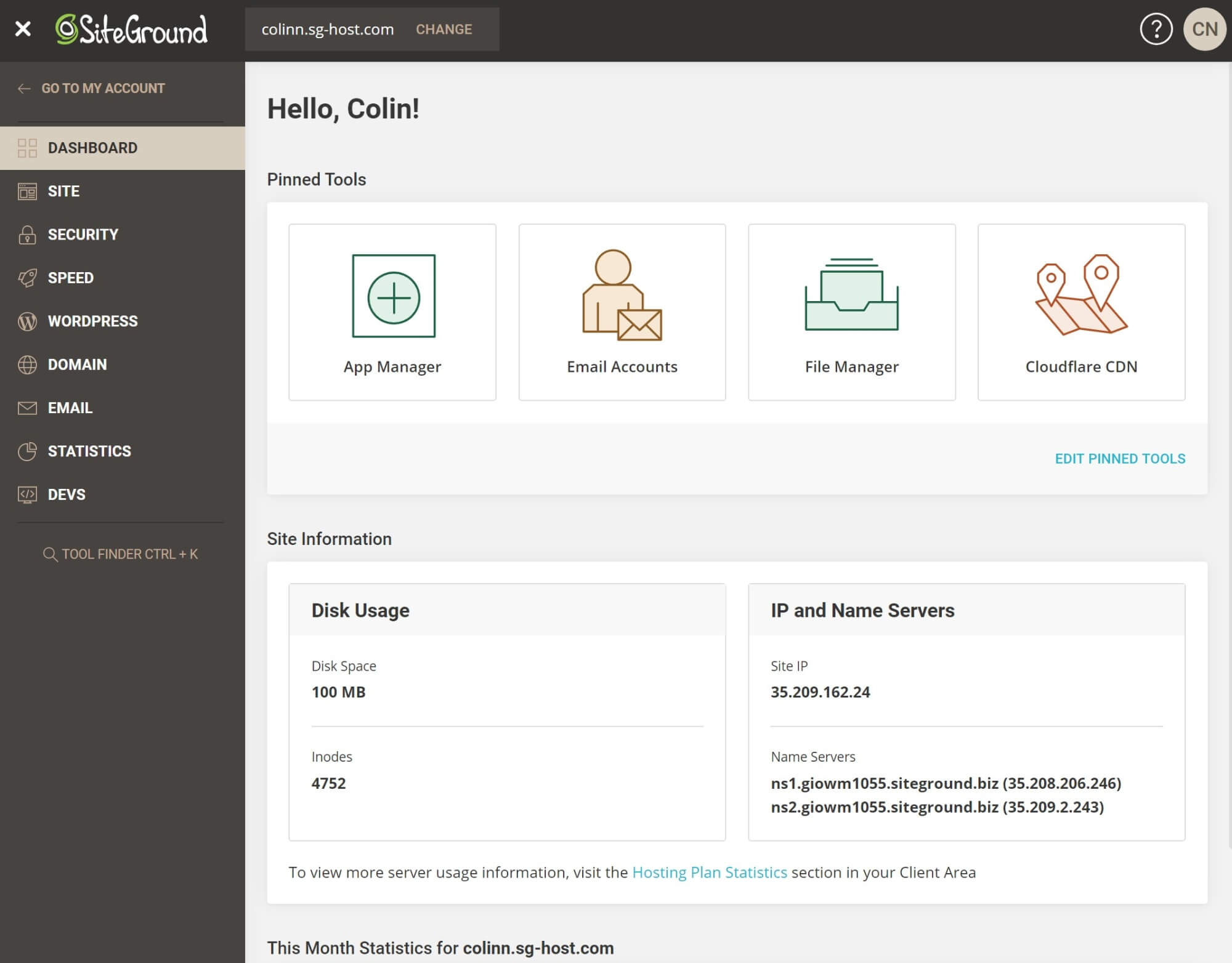
For example, by going to Security → Backups, you can see all of the automatic backups for your site. You can either restore an entire backup or only a partial backup, such as only restoring your database or files. If your plan supports it, you can also take manual backups at any time:
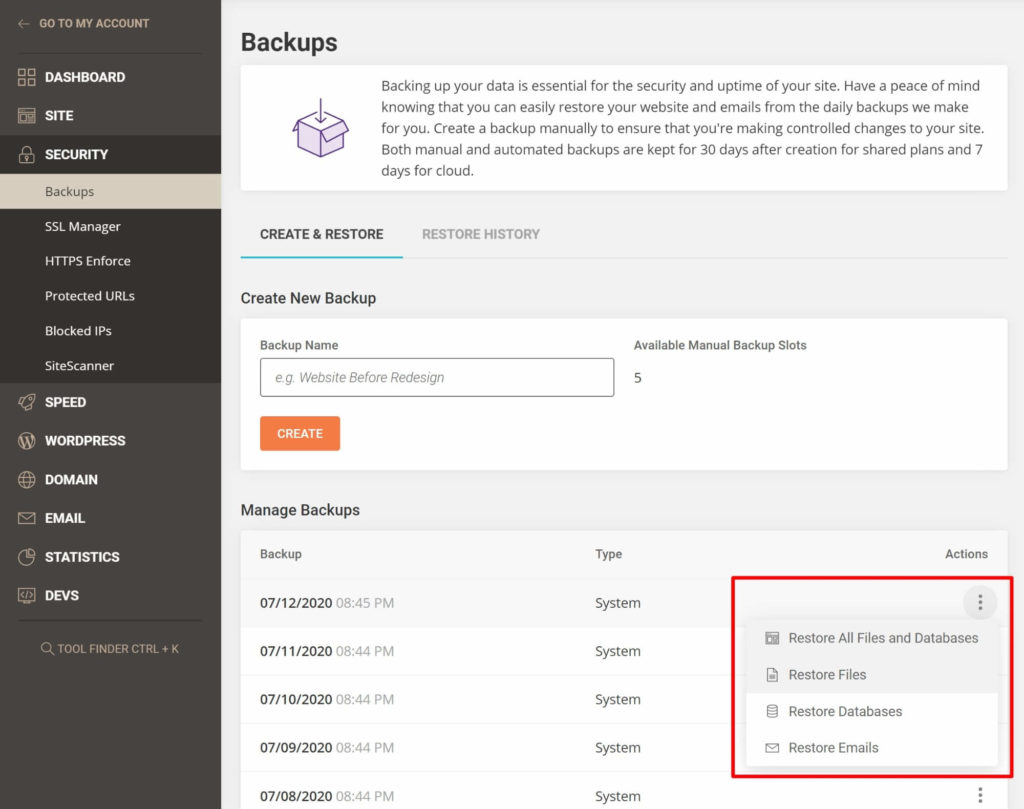
Similarly, if you go to WordPress → Staging, you can easily create and manage staging sites, which are basically a copy of your site in a safe sandbox that you can use for testing. You can also ‘push’ your staging site live to overwrite the live version of your site:
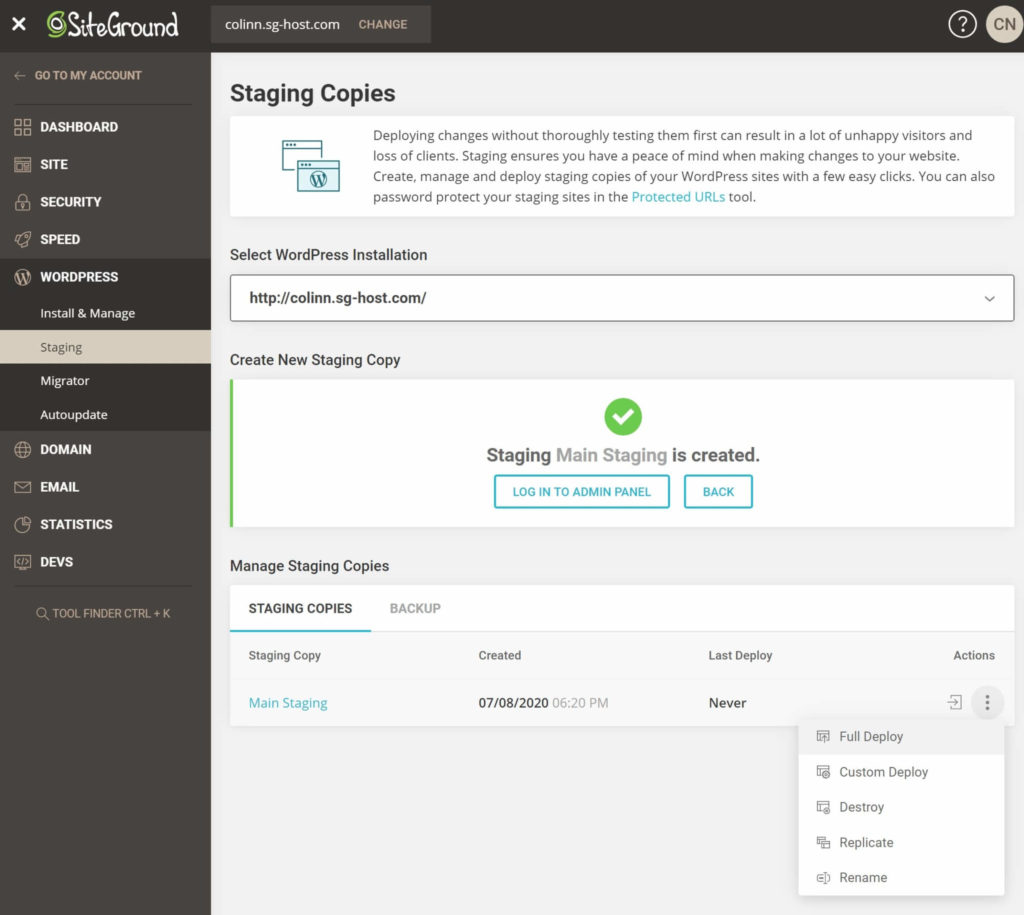
Overall, in these few screenshots, you can see that SiteGround give you a lot of detailed options in their dashboard — definitely more detailed than what DreamHost give you.
Beyond the hosting dashboard, SiteGround also give you the SG Optimizer plugin. You can use this plugin to manage caching from inside your WordPress dashboard and it also helps you to implement tons of other WordPress performance best practices:
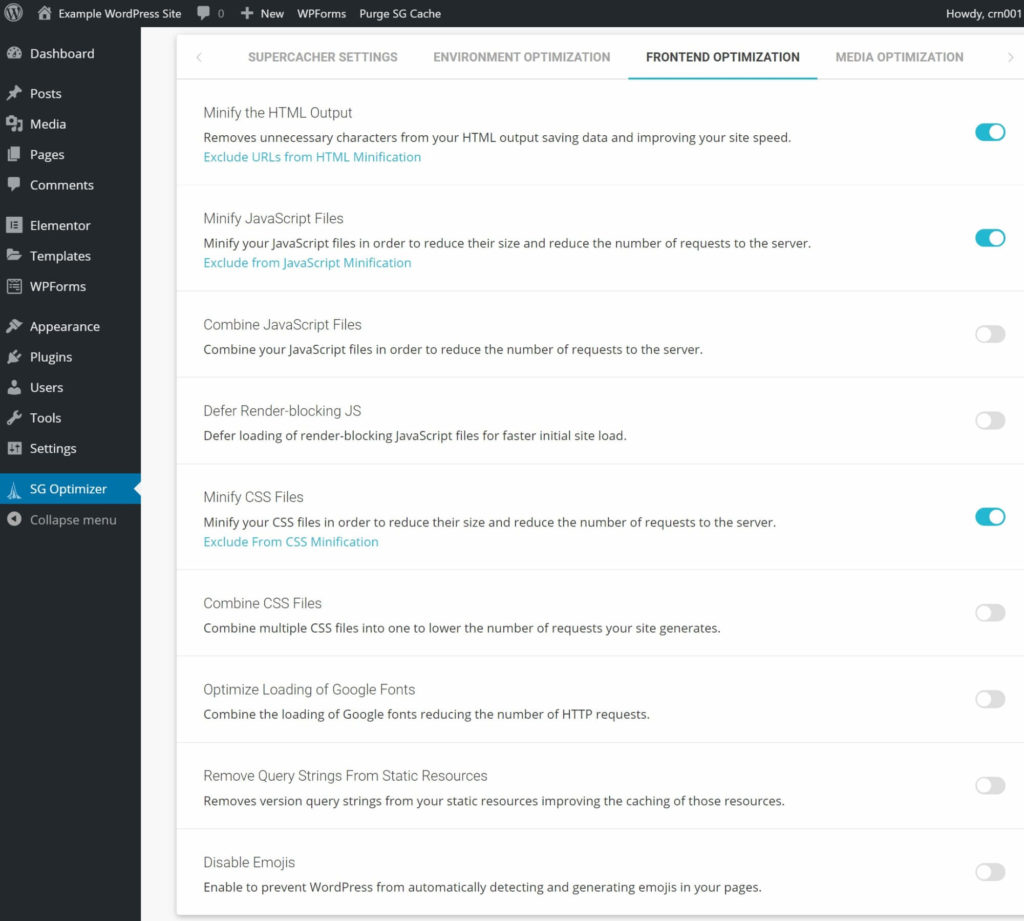
DreamHost
DreamHost also use a 100% custom hosting dashboard, although they don’t give you quite as many tools as SiteGround. I also don’t think DreamHost’s dashboard is quite as logical as SiteGround’s. With that being said, it’s still an above-average hosting dashboard if you compare it with the broader shared WordPress hosting space, so that’s not much of a criticism.
The main DreamHost dashboard gives you a summary of your account — you can use the options on the left to jump around to key areas or DreamHost will also suggest some of the most important areas in the body of the dashboard:
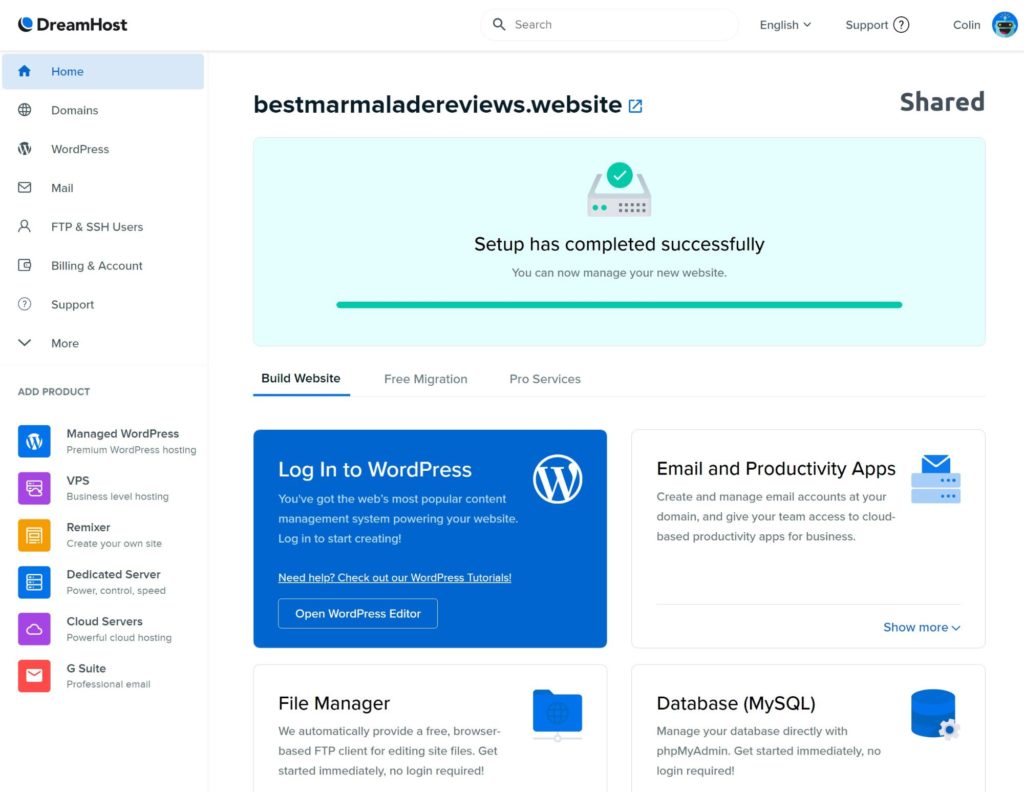
If you want to manage a website, you actually need to go to Domains → Websites, which is a little odd in my opinion (these types of quirks are why I say DreamHost’s dashboard is ‘less logical’). This gives you a quick snapshot of your site:
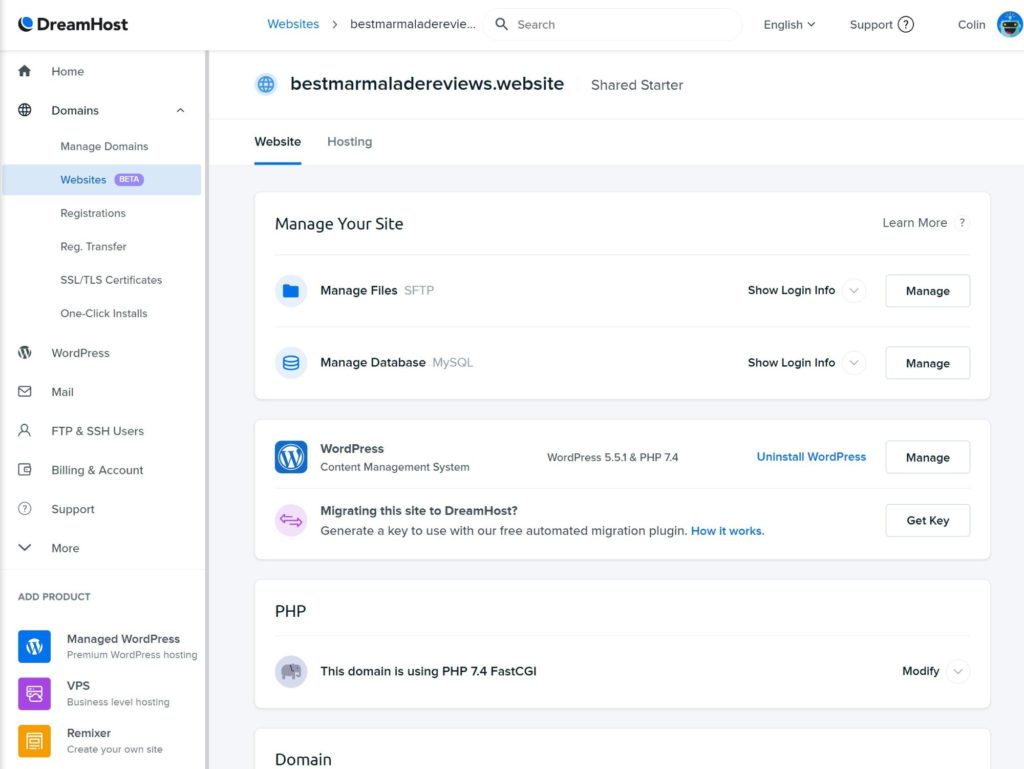
In other areas, you’ll get useful tools such as phpMyAdmin to manage your site’s database, an in-browser file manager tool (in addition to SFTP access) and more:
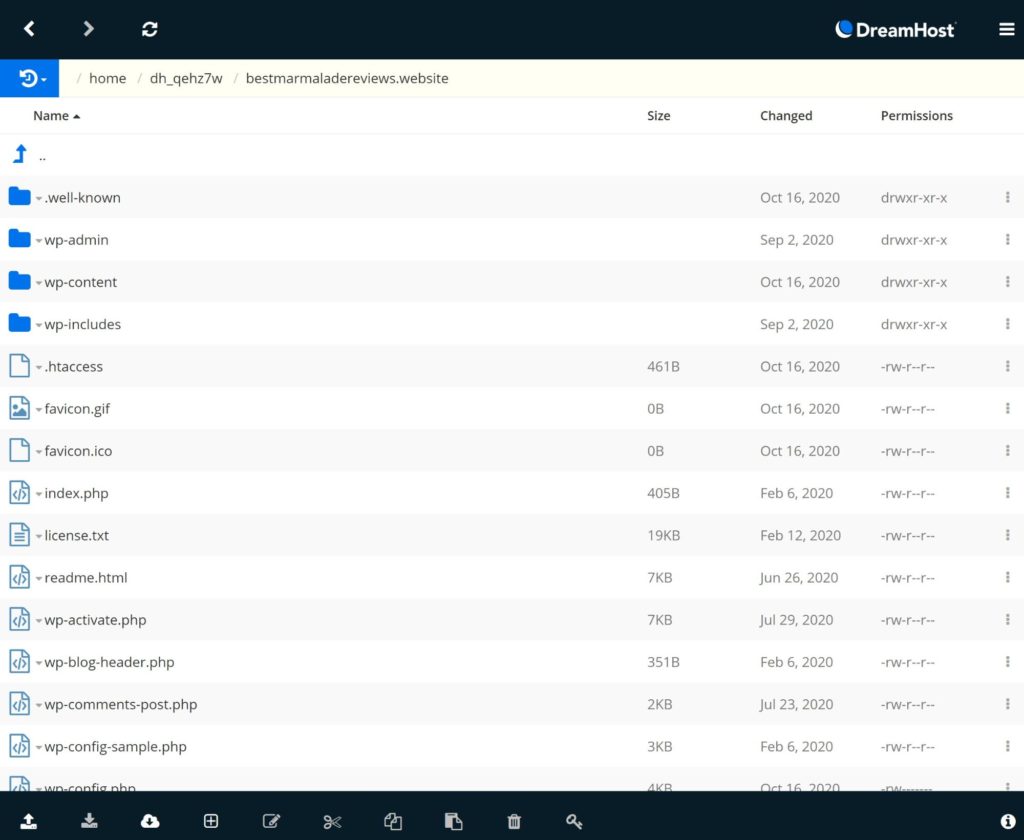
Overall, though, there just aren’t as many features as SiteGround. For example, DreamHost don’t offer staging sites on any of their shared plans. Additionally, the interface to manage/restore backups has very little detail. All you get is a single option to restore from the latest backup, which is a lot less than the flexible backup restore options SiteGround give you:
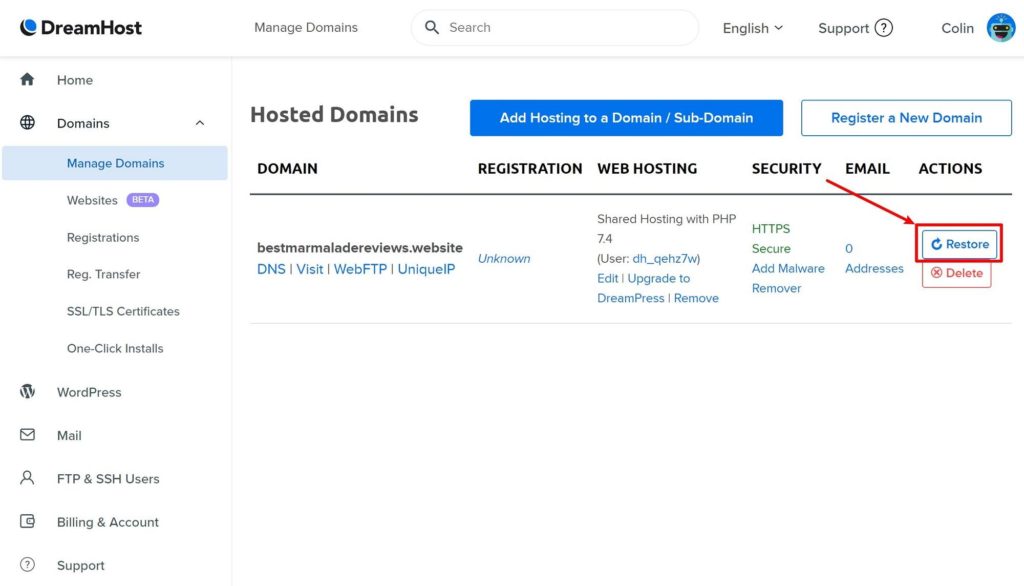
Pricing
So far, SiteGround are looking like the clear choice, right? They’re faster, have more features and have the better dashboard — what’s not to like?
Well, mainly the price. Pricing is the point in this comparison where things start to shift back towards DreamHost because DreamHost are significantly cheaper than SiteGround. While there are a lot of variables to account for, DreamHost can cost around a third of what you’ll pay at SiteGround for similar resources.
There are two main things to consider when comparing prices:
- Promo prices — both hosts offer discounts on your first billing cycle. However, SiteGround offer steeper discounts (and much higher renewal prices), which can make them seem cheaper than they are at first glance.
- Regular prices — regular prices are what you need to pay after your first billing term.
I’ll make sure to list both types of prices. Pay special attention to the regular pricing, as a lot of SiteGround users experience ‘renewal shock’ because SiteGround’s renewal prices can be so much higher than their promo prices.
Let’s look at each host individually, and then I’ll try to compare them on an apples-to-apples basis.
SiteGround Pricing
SiteGround offer three pricing plans:
- StartUp — one website with 10 GB storage for ~10,000 monthly visits.
- GrowBig — unlimited websites with 20 GB storage for ~25,000 monthly visits.
- GoGeek — unlimited websites with 40 GB storage for ~100,000 monthly visits.
You can choose from four different billing cycles:
- Monthly
- One year
- Two years
- Three years
You’ll get the best promo prices with a one-year plan. The two-year promo discount isn’t as big, and you won’t get any promo price for a three-year plan (but you will get a discount for committing to such a long term):
| Monthly | One Year | Two Years | Three Years | |
|---|---|---|---|---|
| StartUp Promo/mo. | – | $6.99 | $9.99 | – |
| StartUp Regular/mo. | $19.99 | $14.99 | $11.99 | $10.49 |
| GrowBig Promo/mo. | – | $9.99 | $14.99 | – |
| GrowBig Regular/mo. | $29.99 | $24.99 | $19.99 | $17.49 |
| GoGeek Promo/mo. | – | $14.99 | $24.99 | – |
| GoGeek Regular/mo. | $44.99 | $39.99 | $31.99 | $27.99 |
DreamHost Pricing
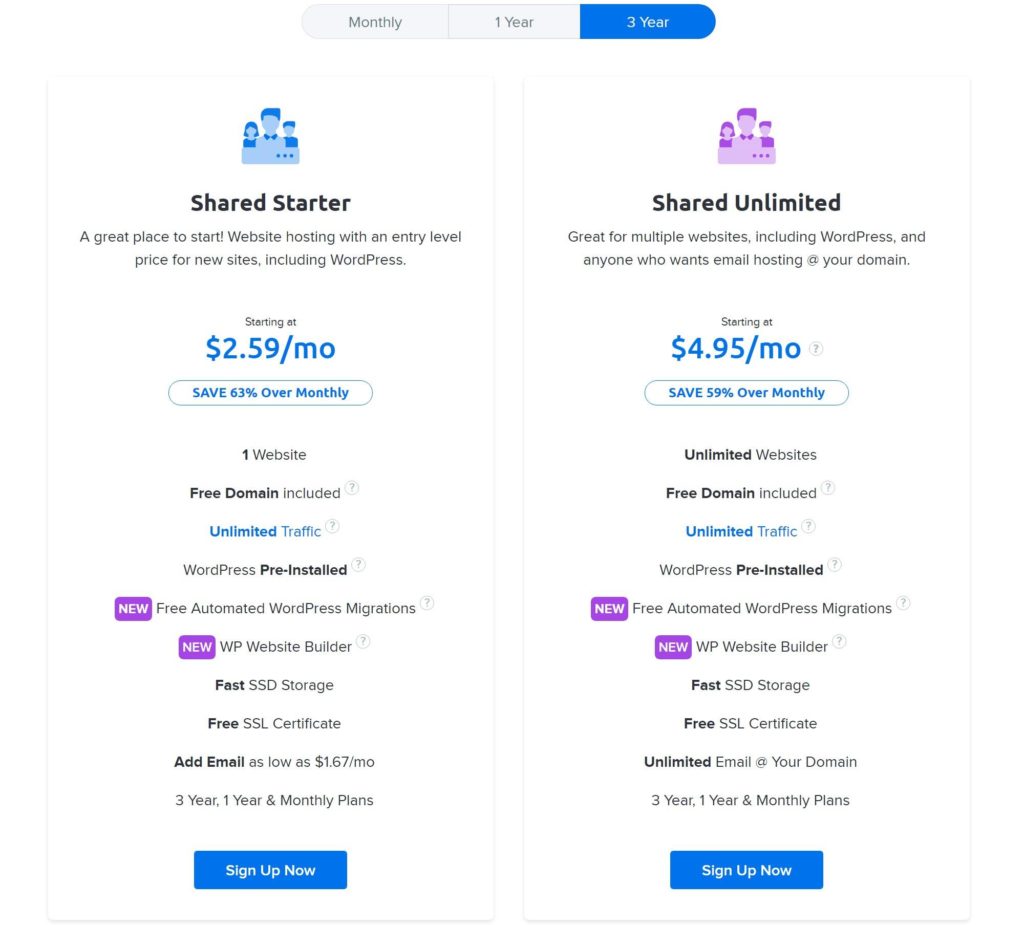
DreamHost offer only two plans for shared WordPress hosting:
- Starter — allows for one website.
- Unlimited — allows for unlimited websites.
You can then choose from three different billing cycles:
- Monthly
- One year
- Three years
There’s no two-year option.
| Monthly Billing | One Year | Three Years | |
|---|---|---|---|
| Starter Promo/mo. | $4.95* | – | – |
| Starter Regular/mo. | $6.99 | $3.95 | $2.59 |
| Unlimited Promo/mo. | $10.95* | $4.95 | $4.95 |
| Unlimited Regular/mo. | $11.99 | $9.95 | $7.95 |
*For your first three months
If you use the Starter plan, you’ll also need to pay an extra $1.67 a month if you want email hosting.
SiteGround vs DreamHost Pricing
To compare SiteGround’s pricing vs DreamHost, let’s look at two specific billing terms:
- Monthly billing
- One-year billing
I’d say SiteGround’s StartUp plan is roughly equal to DreamHost’s Starter plan, and SiteGround’s GrowBig plan is roughly equal to DreamHost’s Unlimited plan. There’s not really a DreamHost equivalent to SiteGround’s GoGeek plan, but I’ll include it in the tables below anyway.
In terms of monthly billing, DreamHost are much cheaper than SiteGround. In fact, I’d recommend avoiding SiteGround’s monthly prices at all costs, as the difference between monthly billing and one-year billing is massive.
| SiteGround StartUp | DreamHost Starter | SiteGround GrowBig | DreamHost Unlimited | SiteGround GrowGeek | |
|---|---|---|---|---|---|
| Promo Price | – | $4.95 | – | $10.95 | – |
| Regular Price | $19.99 | $6.99 | $29.99 | $11.99 | $44.99 |
In terms of one-year billing, the difference isn’t as large, but DreamHost are still significantly cheaper than SiteGround, especially when you look at SiteGround’s regular prices (which are what you need to pay after the first year). Even with SiteGround’s big promo discounts, DreamHost are still cheaper.
| SiteGround StartUp | DreamHost Starter | SiteGround GrowBig | DreamHost Unlimited | SiteGround GrowGeek | |
|---|---|---|---|---|---|
| Promo Price | $6.99 | $3.95 | $9.99 | $4.95 | $14.99 |
| Regular Price | $14.99 | $3.95 | $24.99 | $9.95 | $39.99 |
Support
At some point, you’re going to have to reach out to your host’s support, especially if you’re a beginner. Both SiteGround and DreamHost have quality support, but SiteGround are the clear winners when it comes to both support quality and availability.
Let’s start with availability…
Both SiteGround and DreamHost offer 24/7 support. However, SiteGround offer 24/7 support via live chat, phone and email/ticket, while DreamHost only offer 24/7 support via email/ticket. DreamHost also offer live chat support, but it’s only available from 5.30am to 9.30pm PT. If you’re in the USA, these are quite generous hours and basically the same as 24/7. However, if you’re outside the USA, you may find it frustrating that you can’t access DreamHost’s live chat outside these hours.
DreamHost also offer phone callbacks. That is, you can request to receive a phone call (but you can’t call them directly). Phone callbacks are only available from 6am to 10pm PST, and they aren’t included for free — you’ll need to pay extra to add phone callbacks. You can either pay a monthly fee for a certain number of callbacks a month or pay a one-time fee.
In terms of support quality, I also give the edge to SiteGround, though DreamHost still have pretty good support for their price. This is based on both my personal experiences, as well as third-party data. For example, in CodeinWP’s big hosting survey of 800-plus users, SiteGround had a near-top ranked 4.7-star rating, while DreamHost still had a respectable 4.0-star rating. Both scores out of five.
Overall, SiteGround have better support, but DreamHost still have ‘okay’ support, especially when you factor in how much cheaper DreamHost are.
Recapping SiteGround vs DreamHost
At this point, we’re almost at the end of our comparison. So, to focus your thinking, let’s quickly recap some of the biggest advantages of each host in comparison with the other…
SiteGround
- SiteGround performed better than DreamHost in our tests — SiteGround won two out of three tests and were almost equal in the third.
- At least personally, I find SiteGround’s dashboard to be a little more user/beginner-friendly, though DreamHost aren’t bad.
- SiteGround give you more useful features/tools, such as staging sites and the SG Optimizer performance plugin.
- SiteGround offer better support quality.
- SiteGround offer more support channels, including free phone support, and all of them are available 24/7.
- SiteGround offer data centers on four continents and let you choose your preferred data center (DreamHost only offer USA data centers and you can’t choose).
DreamHost
- DreamHost are way, way cheaper than SiteGround, especially when you factor in SiteGround’s big renewal prices.
- DreamHost give you a free domain name, which ties in with the cost.
- DreamHost give you unlimited resources on the Unlimited plan, while SiteGround don’t. There’s no truly ‘unlimited’ hosting, but the fact is DreamHost are more generous.
Which Host Should You Choose?
Now, for the final, and most important, question. Should you use SiteGround or DreamHost for your website?
Well, as I set up in the beginning, I don’t think there’s a clear answer that applies to all users here. Instead, you need to think about your goals and budget when picking a host.
Let’s start with SiteGround. If you take money out of the equation, they’re definitely the better host in this comparison. They perform better, have better support and, at least in my opinion, have a better dashboard and more useful tools.
If you’re serious about your website and plan to turn it into a business or otherwise make money from it, then I think that investing in SiteGround is your best option. Yes, they’re more expensive, but hosting plays an important role in your success. If your site loads faster, you’ll have happier users, you may rank higher in Google, and you may even sell more (because there’s data suggesting that slow websites leak sales).
However, if you’re going to go with SiteGround, I recommend choosing at least the GrowBig plan, as you’ll need that for most of the useful features, such as server-level caching, staging sites and on-demand backups.
On the other hand, if you’re not planning to turn your website into a serious business, then I actually think DreamHost are good enough for most websites. For example, are you launching a blog that’s mainly for fun? Or maybe something such as a simple portfolio website or basic business brochure site? In those cases, I think you’ll be totally fine with DreamHost and you’ll save a fairly significant amount of money.
No, DreamHost aren’t as good as SiteGround, but for well less than half the money, you’re still getting a solid hosting product and excellent value.
Finally, a last consideration may be your location. DreamHost are mainly focused on just North America, which shows in their limited data center locations and live chat support hours. SiteGround, on the other hand, are more of a global option with data centers on four continents and 24/7 support on all channels. For that reason, SiteGround are almost certainly the better option if you’re outside North America and/or you’re targeting an audience outside North America.
Related Reading:
Used/using either of these hosts? Thoughts?
Discover more from WPMarmalade
Subscribe to get the latest posts sent to your email.

